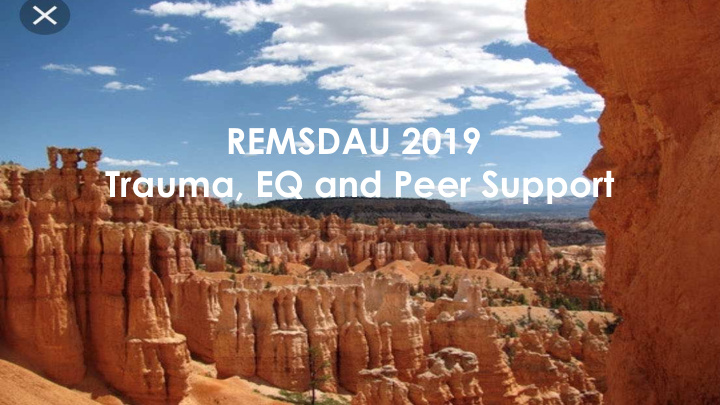



REMSDAU 2019 Trauma, EQ and Peer Support
Courageous What expectations do Resilient you feel as an individual working in Strong EMS? Professional Hero
The Hidden Shut down emotions Landscape Separate work life/personal life What are the personal Don’t feel like “I” fit in costs of Feel alone/isolated doing your Deny or minimize impact job?
RESEARCH Which lead to increased rates of: Research on 1st responders is a Heart disease recent priority so info is limited in Cancer amount and quality. Arthritis Studies show high risk for : Diabetes Depression Suicide Anxiety Shift work leads to sleep deprivation Addiction Repeated exposure to trauma Family dysfunction causes same amount of mental harm as direct exposure
Let’s examine breathing When you inhale, air is drawn in through your When you breathe, typically, you use one of nose, where it is warmed to body temperature, two patterns: 1) chest or thoracic breathing, or humidified, and partially cleansed. Your 2) Abdominal or diaphragmatic breathing. diaphragm, a sheet like muscle separating the Chest or thoracic breathing is common in our lungs and the abdomen, facilitate your modern life and is linked with lifestyle, stress, breathing by contracting and relaxing as you anxiety, or other forms of emotional distress. It is breathe in and out. shallow and often irregular and rapid. Your heart pumps oxygenated blood to all parts Abdominal or diaphragmatic breathing is the of your body. An exchange takes place in which natural breeding of newborn babies and blood cells receive oxygen and release carbon sleeping adults. Diaphragmatic breathing is dioxide, A waste product that is carried back to deeper and slower than chest breathing, as your heart and lungs, and then exhale. This well as more with Nick and relaxing. The efficient method of transporting and exchanging respiratory system is able to do it’s job of oxygen and carbon dioxide is vital to sustain life. producing energy from oxygen and removing waste products.
The big “Ts” and little “ts” of TRAUMA How to cope with trauma and build positive mental health in the EMS profession
Big Ts Little ts Often an event or series of events Often referred to as what should have Most people would agree it’s a trauma happened, but didn’t Identifiable Hard to put a finger on. Sometimes referred to as what did Often times dismissed or not recognized happened that shouldn’t have as trauma Consistent small ts can score higher on PTSD scales than one or two big Ts
In my beginning is my end. ~TS Eliot
Trauma Responses: responses are not voluntary. Subconscious neurobiological level of reading the environment
Trauma Responses
Window of Tolerance If nervous system is in a constant state of One way to regulate is with people in a pro-social positive way. danger, it’s going to make it difficult to detect safety and live in WOT. Social interaction behavior is a neural Misread others cues exercise of using newer mammalian structures to inhibit primitive defense Neutral>>>>>>>>>>>> aggressive systems. (Safe face, safe voice, safe Fearful >>>>>>>>>>>> angry touch)
EMDR: one of only 3 therapies recommended by DOD & Veterans Administration for PTSD
Signs of PTSD: Intrusive Memories these memories can start from the persons os. Thoughts, or can be triggered by words, objects or situations that are reminders of the traumatic event. They include: Recurring, unwanted memories of the event Reliving the event as if it were happening against Upsetting dreams Emotional distress or physical reactions (heart racing, hands sweating)
Avoidance May cause a change in routine to avoid reminders of the event as well as negative changes in thinking and mood: Negative feelings about self/others Feeling emotionally numb Inability to feel Feeling hopeless/helpless Isolating Loss of interest
Hyper-arousal Irritable Emotional outbursts On guard Easily startled Trouble concentrating Difficulty sleeping Loss of appetite
Peer to Peer Support There needs to be a culture change. The goal is: Needs to be ongoing. Can’t do it Happier, healthier employees because it’s a bad day/week. Higher rentention Asking for help, discussing struggles Increased safety and well-being needs to be the new norm. Decrease isolation Create a culture of self-care (sleeping, eating well, hydrating, Empowering employees downtime,music, exercise, Reduce anxiety, depression PTSD prayer/meditation, human contact on a “real” level.
Emotional Intelligence commit, follow-through and work Emotional intelligence is toward the achievement of our goals the level of our ability to: (motivation) Discern the feelings of others, Recognize and understand our understand their emotions, and utilize emotions and reactions (self- that understanding to relate to others awareness) more effectively (empathy) Manage, control, and adapt our Build relationships, relate to others in emotions, mood, reactions, and social situations, lead, negotiate responses (self-management) conflict and work as part of a team Harness our emotions to motivate (social skills) ourselves to take appropriate action,
Emotional intelligence is a gateway to a balanced life. It’s essential to basically every aspect of life As a culture, we don’t teach EQ well or practice it.
Don’t wait until you’re broken down to seek help. There is no reason to carry the burden of what you’ve seen and experienced.
The End
Recommend
More recommend